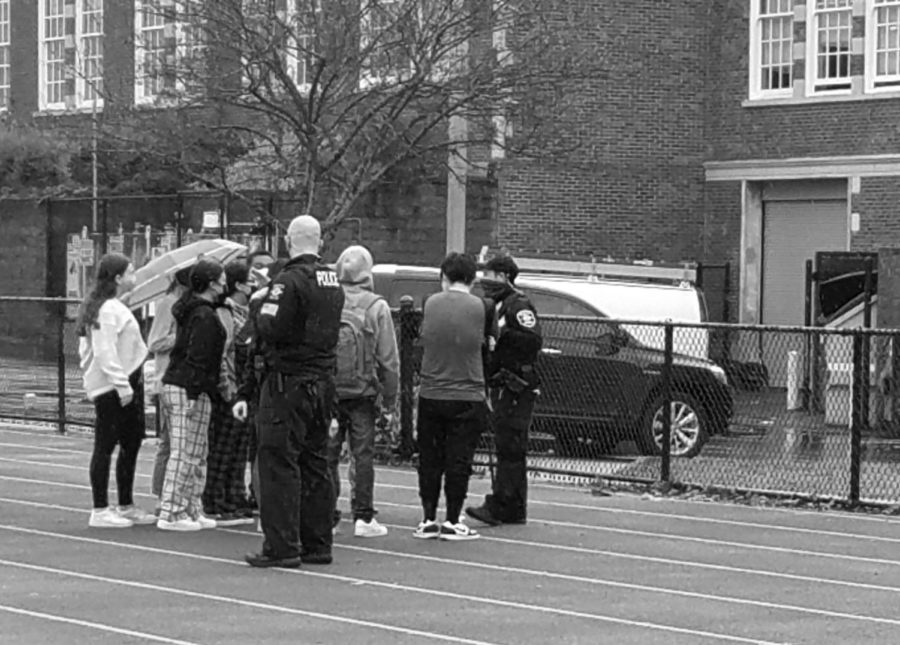Garfield Bomb Threats
Response dictated by varying guidance leaves few in building.
Two bomb threats were made at Garfield High School on the 4th and 5th of November leading to school evacuations and an ongoing investigation. These incidents were riddled with communication errors and revealed procedures many were unaware of.
Flexibility in Responses
In both instances, administrators coordinated with the Seattle Police Department and Safety and Security department, a division of Seattle Public Schools that advises schools in emergency situations. “We provide consultation and guidance for principals, on how they operate their schools, and keeping them safe,” Benjamin Coulter, a department representative, said. “We offer guidance… Every emergency is a little bit different and needs to be handled a little bit differently.”
The variability in response is evident looking at the two situations at Garfield. Following the first bomb threat, students and teachers were evacuated to the field where they were held for an hour before being dismissed. Bomb sniffing dogs swept the building and found nothing. On November 5th, students were not evacuated, but released two minutes before school ended, there was no sweep of school.
“Time of day, credible threat, information that we had all led to the decision in the moment and many of those decisions were not made in isolation they were made with the support of district office and our response through the city 911 call,” Vice Principal Regina Carr said, adding that the caller was believed be the same person.
“A lot of the time, people make these threats because they’re looking for a reaction. And so we have to be careful about what reaction we provide, so that we don’t encourage them to do the same thing.” Coulter said.
Announcements
Also different was the way in which these threats were communicated to the building. During the first bomb threat, administrators opted to alert people by sending staff into each classroom, missing at least three classrooms.
One such classroom was Daniel Young’s, a social studies teacher who was in his prep period.“I was never notified, I figured it out on my own… I saw one class walking out on the sidewalk and I thought, oh maybe they’re walking out on a field trip… I want to say it was maybe 15 minutes after that when I went to make a copy and I noticed the school was really quiet,” Young said.
“I thought back to seeing the class walking out and thought maybe there was an evacuation and I was just in such a workflow that I didn’t hear the announcement or alarm or something. So I grabbed all of my things and jumped out the window,” Young said.
Tim Zimmermann, a language arts teacher, was with a class of students. “I learned about it first from a student. We were taking a quiz in my 9th grade language arts class, and a student called me over and showed me their phone and said that we had to go out to the field,” Zimmermann said.
“I treated that seriously, but I said if they hadn’t told me, I wasn’t totally sure how serious it was,” Zimmermann said. “What ended up happening was one of them texted Mr. Barnes and said, ‘We’re still in here,’ because they forgot about my classroom…”
Garfield administration, however, defended their lack of announcement.“It was in our guidance for that particular situation and what had been done in the building previously,” Carr said.
There is no general guidance on the use of announcement systems. “For any bomb threat, it would be a building level decision [to use an announcement system], a situation level decision. I would feel comfortable saying that there isn’t strong guidance on that specifically. There could be strategic advantages to doing either,” Coulter said.
Evaluation and future response
Despite communication errors administrators evaluated the situation as a success and expressed gratitude for those involved.
“Thank you to our staff, safety teams, law enforcement officers, and bus drivers for their quick action. You helped students move through the evacuation and dismissal process seamlessly,” Principal Hart said in an email sent to parents following the first bomb threat.
Administrators doubled down on their assessment of the situation.“Our timeline from concern of a threat to evacuation of the building was a quick response. I would say it was seamless,” Carr said, adding that this was the first emergency situation since returning to schools.
“Because we have been out of school for two years, we are needing to brush up on all of our processes: fire drills, earthquake drills, threats, all of it,” Carr said. There are no plans to practice bomb threat response specifically, however.
This positive assessment was echoed by Safety and Security. “Sometimes there is a reception out there that if people don’t like their principals or their administrators that [Safety and Security] is going to come in and tell them they are wrong and Seattle Public Schools just doesn’t operate like that,” Coulter said.
“I don’t think anyone got hurt so that means it was handled well… Our focus is did anybody get hurt and when we go through an incident and no one gets hurt we view that as basically a win and a success,” Coulter said.
Those jeopardized by the errors had a different message. “It would be nice if they were thorough and figured out their systems. It is important,” Young said.
No suspect has been apprehended, the investigation is under the control of the Seattle Police Department.
Adam is a senior this year and it is his second year on the Messenger. He is eager to advance the Messenger's goals of spreading awareness of interesting...





